Computational chemistry is a branch of chemistry that uses computer simulation to assist in solving chemical problems. It uses methods of theoretical chemistry, incorporated into computer programs, to calculate the structures and properties of molecules, groups of molecules, and solids. It is essential because, apart from relatively recent results concerning the hydrogen molecular ion, the quantum many-body problem cannot be solved analytically, much less in closed form. While computational results normally complement the information obtained by chemical experiments, it can in some cases predict hitherto unobserved chemical phenomena. It is widely used in the design of new drugs and materials.
Quantum chemistry, also called molecular quantum mechanics, is a branch of physical chemistry focused on the application of quantum mechanics to chemical systems, particularly towards the quantum-mechanical calculation of electronic contributions to physical and chemical properties of molecules, materials, and solutions at the atomic level. These calculations include systematically applied approximations intended to make calculations computationally feasible while still capturing as much information about important contributions to the computed wave functions as well as to observable properties such as structures, spectra, and thermodynamic properties. Quantum chemistry is also concerned with the computation of quantum effects on molecular dynamics and chemical kinetics.
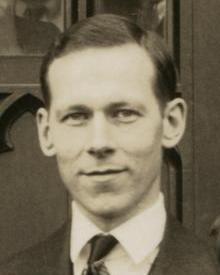
Robert Sanderson Mulliken was an American physicist and chemist, primarily responsible for the early development of molecular orbital theory, i.e. the elaboration of the molecular orbital method of computing the structure of molecules. Mulliken received the Nobel Prize in Chemistry in 1966 and the Priestley Medal in 1983.
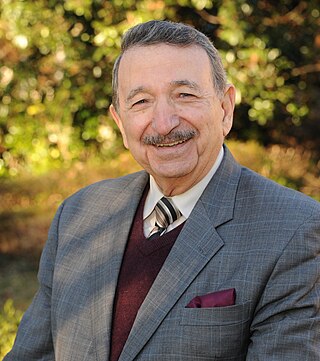
Mostafa A. El-Sayed is an Egyptian-American physical chemist, a leading nanoscience researcher, a member of the National Academy of Sciences and a US National Medal of Science laureate. He was the editor-in-chief of the Journal of Physical Chemistry during a critical period of growth. He is also known for the spectroscopy rule named after him, the El-Sayed rule.

Henry Frederick "Fritz" Schaefer III is a computational and theoretical chemist. He is one of the most highly cited chemists in the world, with a Thomson Reuters H-Index of 121 as of 2020. He is the Graham Perdue Professor of Chemistry and Director of the Center for Computational Chemistry at the University of Georgia. Before becoming professor at Georgia he was professor at University of California, Berkeley and in 2004, he became Professor of Chemistry Emeritus, at UC Berkeley

William Esco Moerner, also known as W. E. Moerner, is an American physical chemist and chemical physicist with current work in the biophysics and imaging of single molecules. He is credited with achieving the first optical detection and spectroscopy of a single molecule in condensed phases, along with his postdoc, Lothar Kador. Optical study of single molecules has subsequently become a widely used single-molecule experiment in chemistry, physics and biology. In 2014, he was awarded the Nobel Prize in Chemistry.
Todd J. Martínez is a David Mulvane Ehrsam and Edward Curtis Franklin Professor of Chemistry at Stanford University and a Professor of Photon Science at the SLAC National Accelerator Laboratory.
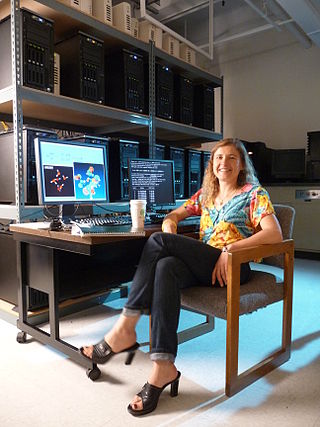
Anna I. Krylov is a Professor of Chemistry at the University of Southern California (USC), working in the field of theoretical and computational quantum chemistry. She is the inventor of the spin-flip method. Krylov is the president of Q-Chem, Inc. and an elected member of the International Academy of Quantum Molecular Science and the Academia Europaea.
Herbert Sander Gutowsky was an American chemist who was a professor of chemistry at the University of Illinois Urbana-Champaign. Gutowsky was the first to apply nuclear magnetic resonance (NMR) methods to the field of chemistry. He used nuclear magnetic resonance spectroscopy to determine the structure of molecules. His pioneering work developed experimental control of NMR as a scientific instrument, connected experimental observations with theoretical models, and made NMR one of the most effective analytical tools for analysis of molecular structure and dynamics in liquids, solids, and gases, used in chemical and medical research, His work was relevant to the solving of problems in chemistry, biochemistry, and materials science, and has influenced many of the subfields of more recent NMR spectroscopy.

Joshua Jortner is an Israeli physical chemist. He is a professor emeritus at the School of Chemistry, The Sackler Faculty of Exact Sciences, Tel Aviv University in Tel Aviv, Israel.

Debashis Mukherjee is a theoretical chemist, well known for his research in the fields of molecular many body theory, theoretical spectroscopy, finite temperature non-perturbative many body theories. Mukherjee has been the first to develop and implement a class of many-body methods for electronic structure which are now standard works in the field. These methods, collectively called multireference coupled cluster formalisms, are versatile and powerful methods for predicting with quantitative accuracy the energetics and cross-sections of a vast range of molecular excitations and ionization. A long-standing problem of guaranteeing proper scaling of energy for many electron wave-functions of arbitrary complexity has also been first resolved by him. He has also been the first to develop a rigorously size-extensive state-specific multi-reference coupled cluster formalism, and its perturbative counterpart which is getting increasingly recognized as a very promising methodological advance.
The Faculty of Chemistry and Earth Sciences is one of twelve faculties at the University of Heidelberg. It comprises the Institute of Inorganic Chemistry, Institute of Organic Chemistry, Institute of Physical Chemistry, Institute of Geography, Institute of Geology and Paleontology, Institute of Mineralogy, and the Institute of Environmental Geochemistry. Chemistry was established as a separate discipline at the University of Heidelberg in 1817 with Leopold Gmelin being appointed ordinary professor of chemistry and medicine. 1895 is considered to be the date of foundation of Geography at the University of Heidelberg as it was from this year on that lectures in physical and mathematical geography were held on a regular basis. In 1899 the first professorship in geography was established, filled by Alfred Hettner.
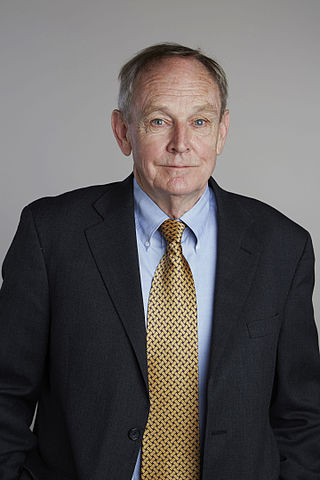
William Hughes Miller is an American professor at the University of California, Berkeley and a leading researcher in the field of theoretical chemistry.
Sourav Pal is an Indian theoretical chemist and former professor of chemistry at IIT Bombay, and former director of the Indian Institute of Science Education and Research, Kolkata. He was a director of the CSIR-National Chemical Laboratory in Pune and an adjunct professor at the Indian Institute of Science Education and Research, Pune.
LiHe is a compound of helium and lithium. The substance is a cold low-density gas made of Van der Waals molecules, each composed of a helium atom and lithium atom bound by van der Waals force. The preparation of LiHe opens up the possibility to prepare other helium dimers, and beyond that multi-atom clusters that could be used to investigate Efimov states and Casimir retardation effects.
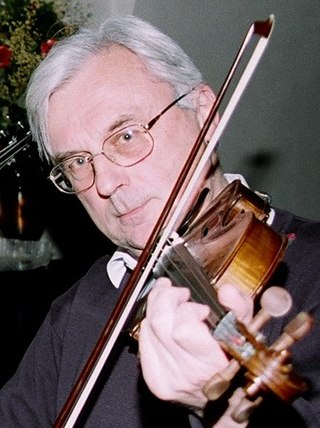
Prof. RNDr. Jiří Horáček, DrSc. is a Czech theoretical physicist, professor at Charles University in Prague, where he works at the Institute of Theoretical Physics, which is a part of the Faculty of Mathematics and Physics. He was the director of the Institute in 2003–2011. He works in the field of theoretical atomic and molecular physics with a special focus on numerical solutions to integral and differential equations of scattering theory and on numerical analytic continuation methods localizing the poles of scattering quantities related to resonances.

Bidyendu Mohan Deb is an Indian theoretical chemist, chemical physicist and a professor at the Indian Institute of Science Education and Research, Kolkata (IISER). he is known for his studies in theoretical chemistry and chemical physics. He is an elected fellow of the International Union of Pure and Applied Chemistry, The World Academy of Sciences, Indian National Science Academy and the Indian Academy of Sciences. The Council of Scientific and Industrial Research, the apex agency of the Government of India for scientific research, awarded him the Shanti Swarup Bhatnagar Prize for Science and Technology, one of the highest Indian science awards, in 1981, for his contributions to chemical sciences.
Suryanarayanasastry Ramasesha is an Indian quantum chemist and a former Dean of the Faculty of Science at the Indian Institute of Science. He is a former chair of the Solid State and Structural Chemistry Unit and Amrut Modi Chair professor of Chemical Sciences at IISc. He is known for his studies on conjugated organic systems and low-dimensional solids and is an elected fellow of the Indian National Science Academy, the Indian Academy of Sciences and The World Academy of Sciences. The Council of Scientific and Industrial Research, the apex agency of the Government of India for scientific research, awarded him the Shanti Swarup Bhatnagar Prize for Science and Technology, one of the highest Indian science awards, in 1992, for his contributions to chemical sciences.
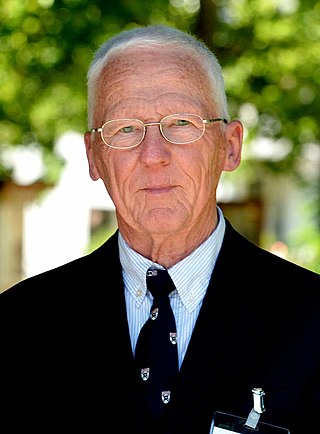
Geerd Heinrich Friedrich Diercksen is a German theoretical chemist and a pioneer in computational chemistry. In 1963 he was awarded his PhD, supervised by Heinz-Werner Preuß at the Johann Wolfgang Goethe-Universität in Frankfurt am Main, in 1973 he was awarded his habilitation in Chemistry by the Technische Universität München and in 1983 he was appointed professor. From 1965 to 2001 he worked as scientific staff at the Max-Planck-Institut für Astrophysik and since 2001 he works there as scientist emeritus.
Georg Hohlneicher was a German solid state physicist and professor at the University of Cologne.










